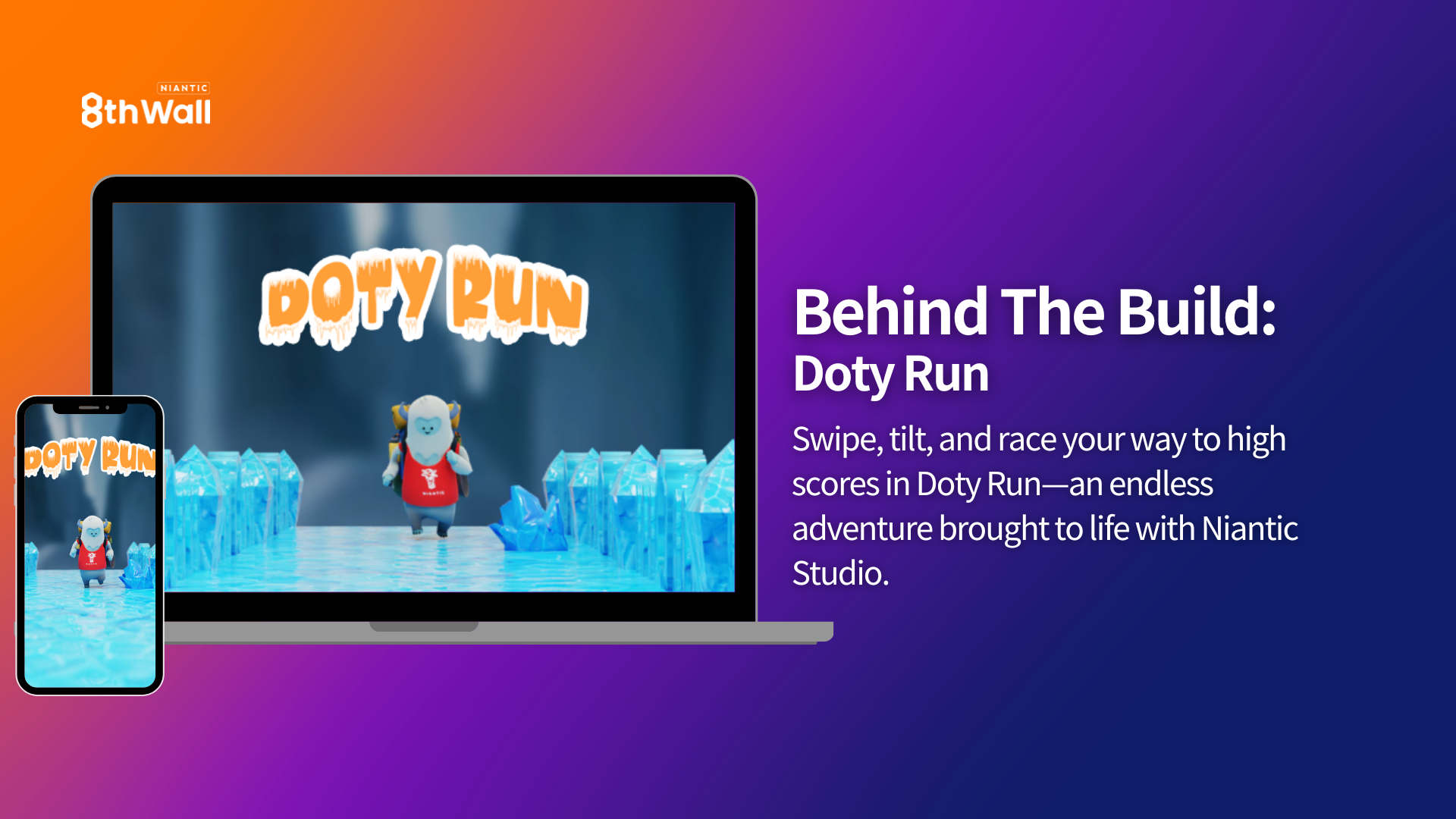8th Wall Blog
Behind the Build: Navigate Ice-Cold Paths in this Thrilling Endless Runner
Swipe, tilt, and race your way to high scores in Doty Run—an endless adventure brought to life with Niantic Studio.

Developer Camilo Medina created Doty Run, an endless runner game with dynamic gameplay, procedural generation, and innovative mechanics. Guided by the adventurous Doty, players navigate an icy trail filled with coins, obstacles, and sharp turns—all while chasing high scores. Camilo’s project highlights the power of Niantic Studio to build complex, interactive web games. We had the chance to delve into Camilo’s creative journey and learn how he brought Doty Run to life.
.png)
What inspired you to create Doty Run?
I have always enjoyed playing Temple Run, and that inspired me to create a similar endless runner experience. Doty Run was my way of pushing Niantic Studio's capabilities to the limit, combining procedural generation, dynamic inputs, and interactive gameplay to recreate the thrill of that classic game.
How did Niantic Studio help bring your vision for this project to life? Were there specific tools or features that were essential?
Niantic Studio facilitated the creation of Doty Run through its ECS framework, comprehensive documentation, and physics system. The input manager simplified the integration of controls and gestures, while access to JavaScript enabled the use of gyroscope data. Additionally, Three.js support made it possible to implement dynamic fog effects.
Were there any challenges along the way? How did you overcome them?
When I was developing Doty Run, I faced some challenges with the UI system, entity tagging, and adding visual effects like fog. To make the UI look better, I used custom HTML and CSS along with scripts like ui-gameplay.ts to handle updates and improve styling. Since Studio doesn’t have a tagging system, I solved collision filtering by using the objectThree property and creating a clear naming convention for all entities. For the fog effect, I used the fog-controller.ts script to access Studio’s Three.js engine and configure the fog dynamically, making the path look endless.
What were the main steps you took to make this project that would be helpful to share with other developers?
- Define the core gameplay mechanic: Keep the player stationary while moving the path to simplify collision detection, camera logic, and avoid floating-point precision issues.
- Organize the project structure: Divide the project into modular and reusable components to improve maintainability and debugging.
- Enhance the UI: Use custom HTML and CSS for better styling and flexibility.
- Implement procedural generation: Create an endless path and dynamically place objects like coins and obstacles to maintain gameplay flow.
- Add immersive visual effects: Use fog and other effects to enhance the endless feel and hide the real-time generation of tiles and objects.
What advice would you give other developers interested in building real-world games, 3D games, or AR experiences with Niantic Studio?
Start by structuring your project with clear, modular components to make it easier to manage and scale. Use Studio’s built-in tools, but don’t hesitate to enhance functionality with custom scripts and take advantage of Studio’s real-world integration features to create engaging, immersive experiences that connect with the players.
Top Features in Doty Run:
- Dynamic gameplay mechanics: Players tilt their phones to move Doty sideways and swipe to jump, roll, or turn—making every session intuitive and engaging.
- Procedurally generated paths: The endless trail keeps gameplay fresh with dynamic object placement and random tile configurations.
- Stylized visual effects: Fog enhances the visual depth of the scene, creating the illusion of an endless icy path.
- Interactive UI system: Responsive HTML and CSS elements deliver polished start, gameplay, and game-over screens for a seamless user experience.
- Gyroscope integration: Leveraging mobile devices’ gyroscopes, Doty Run delivers immersive and precise tilt controls for an authentic runner experience.
Pro Tips for Aspiring Developers:
- Simplify movement mechanics:
Instead of moving the player character, move the environment to reduce computation errors and simplify logic. - Leverage modular components::
Build modular ECS components for reusability and streamlined debugging. - Incorporate visual enhancements:
Features like fog effects or custom UI styling can significantly elevate user experience. - Test early and often:
Iteratively test gameplay mechanics to ensure smooth performance and enjoyable interactions.
Ready to Guide Doty on an Endless Adventure?
Doty Run showcases the limitless potential of Niantic Studio for creating polished, immersive gaming experiences. Want to dive deeper into Camilo’s process? Explore the full project documentation and learn from his detailed breakdown of gameplay mechanics, visual effects, and procedural generation.
Check out Camilo's sample projects to kickstart your endless runner experience:
- Studio: Player Controller – Learn how to implement a player controller that responds to input actions and touch gestures.
- Studio: Gyroscope Controller – Master gyroscope-based tilt controls for intuitive and immersive gameplay.
Start building, start running, and let Doty Run inspire your next big idea! Create a free account today to start building with Niantic Studio.
.png)